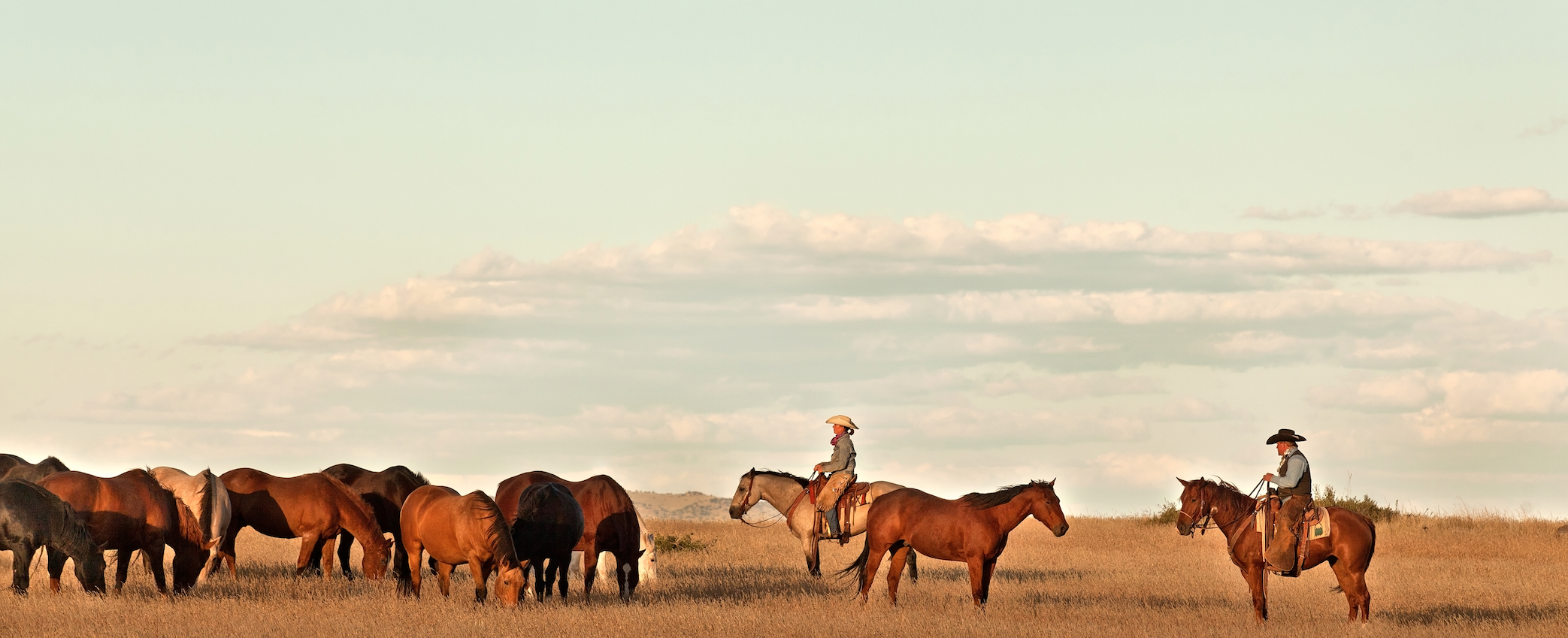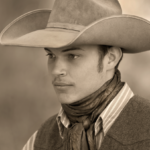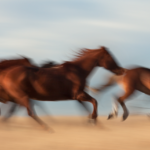Writer Amanda Christmann
Photography by Scott Baxter
[dropcap]I[/dropcap] first noticed Scott Baxter’s work in 2012 as I made my way through the halls of Sky Harbor Airport. Homesick and weary from a long trip abroad, I looked up to see black and white portraits and scenery he’d captured for his Centennial Legacy Project, “100 Years 100 Ranchers.” He’d managed to depict Arizona ranch life so vividly and provocatively that I wanted to grab the nearest person by the shoulders and exclaim, “This is my home! These are my people!”
Of course, I’d heard of him in other circles, too. Through the years, his award-winning work appeared in some of my favorite magazines-American Cowboy, Arizona Highways, Cowboys & Indians, and Western Horseman to name a few.
As I walked into Local Jonny’s in Cave Creek, I scanned the crowd and landed on an affable smile framed by eyes weathered by sunshine and a two-day-old beard. Wearing a blue and white flannel plaid shirt and comfortable jeans, he could have easily passed for one of the ranchers whose images have earned him his reputation.
Sizing him up, I ordered my coffee black. We sat down and talked photography, writing and life.
The Art of Photography and the Pull of the Southwest
Scott was born in Hartford, Connecticut and grew up in Princeton, New Jersey, the son of an oil engineer and a teacher.
It’s difficult to imagine this near-native Arizonan as a prep school lacrosse player, but he was; he even earned a college scholarship to The College of Wooster and was co-captain of the team in 1979. He completed his degree in history, never dreaming he’d end up documenting it.
“I took classes in art history and painting, but I was a terrible artist,” he laughs. “I couldn’t draw worth anything.”
It wasn’t until he graduated and took a job in education that he learned about photography-from the most unlikely of teachers. One of his ninth-grade students taught him how to develop film in the school’s dark room. As the images emerged on photo paper beneath the red lights, something awoke in Scott.
He began to snap photos in his spare time and realized he might be on to something.
Not everyone was enthused. “Much to the chagrin of my school teacher mother, I decided to become a photographer,” Scott says sardonically.
He came to Phoenix in the spring of 1982 to go to grad school at Arizona State University. “It was nothing but hot,” he said. “I just remember thinking, ‘I hate this place!’ I had $180 to my name, and I decided I wasn’t going to stay. Then I got offered a job as a commercial photographer Cairns, and that changed those plans.”
Finding the Magic
Scott spent years honing his craft, and he did so through an era of change in photography. He still enjoys using film cameras and keeps a cache of them handy-a Linhof Technikardan 4×5, Calumet 8×10, Pentax 6×7, Hasselblad 500CM, and 1955 twin-lens Rolleiflex-but he has also joined the rest of the world in the switch to digital, albeit reluctantly.
“When digital first came, I hated it,” he recalls. “I remember saying, ‘I’m never doing this,’ but here I am. I’ve learned that it’s not the camera or the equipment that matters. If you’re really passionate about what you do, it works itself out.”
And he was passionate about what he did.
Early on, Scott realized had the intuitive ability to differentiate between taking a picture and shooting a photo that told a story. “I came from kind of a stoic upbringing, but somehow I feel like I’m more connected emotionally to people,” he says with a quizzical look in his eyes, as if he is waiting to see if I understand.
“It wouldn’t make any sense to do this if I couldn’t connect with people. If that were the case, I’d like to think I’d see it and say, ‘I think I should go shoot buildings.”
He built his career in commercial photography on that skill – shooting provocative images that audiences could relate to through his eyes. Eventually, he figured out that people also wanted to put his work up on their walls.
Looking at Scott’s work, he doesn’t photograph subjects so much as he documents them. Every one of his pictures draws the viewer in and insists on sharing something more. Sometimes he makes us wonder, “What happens next?” Other times, through penetrating eyes or through an expression, he makes us feel the very soul of the person he is portraying.
What’s incredible about it is that he doesn’t try to do it.
A shoulder drops or hands relax. Snap.
A stiff pose turns into a calm exhale. Snap.
Awkwardness turns into a comfortable smile. Snap.
He doesn’t see it; he feels it.
“The magic for me is in the experience itself,” he says. “The photographs are just the end of the story.”
“Kind of Western for a Yankee”
Among his most notable work, Scott completed “100 Years 100 Ranchers,” an official Legacy Project for the Arizona Centennial that has been featured in corporate and museum exhibits and presentations across the state. It took 10 years for Scott to complete, part of which his daughter Lily assisted with.
Scott’s criterion was tough. “There were several things these families had to do to qualify,” he explains. “For example, they had to have ranched in Arizona for 100 years. If they had only been ranching for 97 years, they didn’t make the cut. It was tough!”
He camped out. He shared meals with ranch hands. He rode along on cattle drives. Along the way he met people, some now gone, whose stories became part of his own.
One of his proudest moments came in the way of a backhanded compliment from his friend and Ranch Cook, Frank Drew. “You’re kind of Western for a Yankee,” Drew told him. And it’s true.
Scott’s stark image of rancher, Sam Udall entitled “First Snow” was featured on the December, 2011 cover of Arizona Highways 50 Greatest Photos edition. That photograph remains one of the most iconic of the collection, but it’s not something Scott looks back on. It was the camaraderie he built with Udall that left a lasting impression.
Udall, from Springerville, welcomed Scott and his daughters into his home time and again. At the age of 70, he had become unable to ranch and moved into town. This summer, during a dark, stormy evening, Udall stepped out into traffic on the town’s Main Street. He was struck and killed. His memory lives on through Scott’s photographs, but bits of his wisdom and wit have planted themselves deep inside Scott.
“I spent many hours and traveled many miles with Sam,” Scott says, leaning back into a weathered leather chair. “Whenever we were riding, or traveling and I would ask how long or far our destination was, he would always say, ‘Scotsman, it’s just a quick lope and a cigarette.’
“He always made me feel like I would make it, and that it would work out in the end.”
For Scott, it will most certainly work out in the end, but more importantly, it has been a memorable, artful journey.
Scott Baxter “Top Hand” Exhibit
Through Jan. 11
Thursday Evenings, 7–9 p.m.
Fiat Lux Gallery
6919 E. 1st Ave., Scottsdale
480-280-8000










Comments by Admin